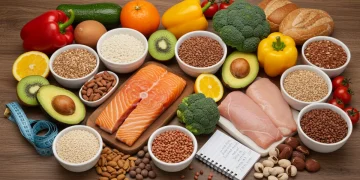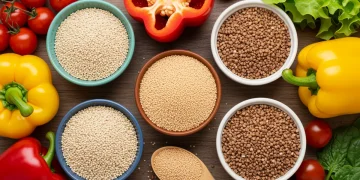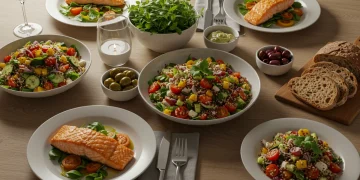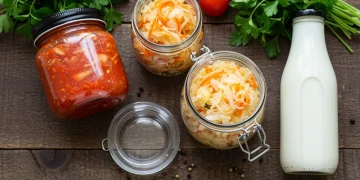Top 10 Anti-Inflammatory Recipes for Gut Health in 2025

The top 10 anti-inflammatory recipes for gut health in 2025 offer practical, delicious ways to reduce chronic inflammation by up to 20%, significantly enhancing digestive well-being and overall vitality.
Are you ready to transform your health from the inside out? Discovering the top 10 anti-inflammatory recipes for gut health in 2025: insider strategies to reduce chronic inflammation by 20% is more than just a diet trend; it’s a profound commitment to your well-being. This guide will provide you with actionable, delicious ways to nurture your gut and significantly diminish inflammatory responses, paving the way for a healthier, more vibrant you.
Understanding chronic inflammation and its gut connection
Chronic inflammation is a silent threat, subtly eroding our health over time. Unlike acute inflammation, which is a beneficial response to injury, chronic inflammation persists, contributing to a myriad of health issues from autoimmune diseases to heart conditions and even certain cancers. The gut, often referred to as our ‘second brain,’ plays a pivotal role in this complex process.
A healthy gut microbiome, teeming with diverse beneficial bacteria, acts as a critical barrier against inflammatory triggers. When this delicate balance is disrupted, a condition known as dysbiosis, the gut lining can become permeable, leading to a ‘leaky gut.’ This allows undigested food particles, toxins, and pathogens to enter the bloodstream, triggering a widespread inflammatory response throughout the body. Addressing gut health is therefore paramount in managing and reducing chronic inflammation.
The vital role of gut microbiome diversity
The diversity of your gut microbiome is a cornerstone of robust health. A rich and varied bacterial ecosystem helps to:
- Produce short-chain fatty acids (SCFAs) like butyrate, which nourish gut cells and reduce inflammation.
- Strengthen the gut barrier, preventing harmful substances from entering the bloodstream.
- Modulate the immune system, preventing overreactions that lead to chronic inflammation.
- Aid in the digestion and absorption of nutrients, supporting overall bodily functions.
Without adequate diversity, the gut becomes more susceptible to imbalances, setting the stage for chronic inflammation. Our dietary choices are the most powerful tool we have to cultivate this diversity, making anti-inflammatory recipes an essential strategy.
In essence, reducing chronic inflammation begins with healing and supporting your gut. By understanding this fundamental connection, we empower ourselves to make informed dietary choices that directly impact our long-term health and vitality.
Key anti-inflammatory ingredients to embrace
Building an anti-inflammatory diet revolves around incorporating specific powerhouse ingredients known for their potent health benefits. These foods are rich in antioxidants, fiber, and beneficial compounds that actively work to calm inflammation and support gut integrity. Knowing which ingredients to prioritize is the first step toward crafting effective anti-inflammatory meals.
Think beyond just avoiding inflammatory foods; focus on actively including ingredients that fight inflammation. This proactive approach not only helps to reduce existing inflammation but also builds resilience against future inflammatory responses, creating a more harmonious internal environment.
Spices and herbs: nature’s anti-inflammatories
Certain spices and herbs are celebrated for their remarkable anti-inflammatory properties. Integrating them into your daily cooking can significantly boost the health benefits of your meals.
- Turmeric: Contains curcumin, a powerful anti-inflammatory compound.
- Ginger: Known for its anti-nausea and anti-inflammatory effects.
- Garlic: Offers immune-boosting and anti-inflammatory benefits.
- Cinnamon: Helps regulate blood sugar and reduce inflammation.
- Rosemary and Thyme: Rich in antioxidants that combat oxidative stress.
These natural flavor enhancers do more than just taste good; they are medicinal powerhouses that contribute directly to your anti-inflammatory goals. Don’t shy away from experimenting with them in various dishes.
Beyond spices, a diet rich in colorful fruits and vegetables, healthy fats, and lean proteins forms the backbone of an anti-inflammatory eating plan. These ingredients work synergistically to provide a comprehensive defense against chronic inflammation and promote overall gut health.
The top 10 anti-inflammatory recipes for gut health in 2025
Here, we unveil a collection of recipes meticulously chosen to support gut health and actively reduce inflammation. These dishes are not only packed with beneficial ingredients but are also designed to be delicious and easy to integrate into your weekly meal plan. Each recipe focuses on nutrient density and flavor, proving that healthy eating doesn’t have to be bland.
From breakfast options that kickstart your day with healing ingredients to hearty dinners that satisfy and nourish, this selection provides a diverse range of meals. Incorporating these recipes regularly can be a game-changer in your journey toward improved gut health and a significant reduction in chronic inflammation.
1. Turmeric-ginger lentil soup
This warming soup is a cornerstone of anti-inflammatory eating. Turmeric provides potent curcumin, while ginger adds a soothing, anti-inflammatory kick. Lentils offer fiber for gut health and plant-based protein.
To prepare, sauté onions, garlic, and ginger, then add turmeric, cumin, and coriander. Stir in red lentils, vegetable broth, and diced carrots. Simmer until lentils are tender, then blend a portion for a creamy texture. Garnish with fresh cilantro and a squeeze of lime.
2. Salmon with roasted broccoli and sweet potato
Rich in omega-3 fatty acids, salmon is a powerful anti-inflammatory food. Broccoli provides sulforaphane, and sweet potatoes are packed with antioxidants and fiber.
Roast broccoli and sweet potato chunks with olive oil, salt, and pepper. Bake salmon fillets alongside, seasoned with lemon and dill. This simple meal is incredibly effective for reducing inflammation.
3. Berry and spinach smoothie with flax seeds
Berries are loaded with antioxidants, spinach is a nutrient-dense leafy green, and flax seeds provide omega-3s and fiber. This smoothie is a perfect breakfast or snack.
- 1 cup mixed berries (frozen)
- 1 handful fresh spinach
- 1 tablespoon ground flax seeds
- 1/2 cup unsweetened almond milk
- 1/2 banana (optional, for sweetness)
Blend all ingredients until smooth. This quick and easy option is a fantastic way to flood your body with anti-inflammatory nutrients.
4. Quinoa salad with avocado, cucumber, and chickpeas
Quinoa is a complete protein and a good source of fiber. Avocado provides healthy fats, while cucumber and chickpeas add hydration and plant-based protein. This salad is refreshing and incredibly gut-friendly.
Cook quinoa according to package directions. Once cooled, toss with diced avocado, cucumber, cherry tomatoes, and chickpeas. Dress with a lemon-tahini dressing for added flavor and healthy fats.
5. Chicken and vegetable stir-fry with brown rice
Lean protein from chicken combined with a colorful array of vegetables (bell peppers, snap peas, bok choy) ensures a nutrient-rich meal. Brown rice offers complex carbohydrates and fiber.
Stir-fry chicken pieces with your favorite anti-inflammatory vegetables in a wok with a light soy sauce or tamari, ginger, and garlic. Serve over brown rice for a balanced and satisfying dish.
6. Overnight oats with chia seeds and walnuts
Oats are a fantastic source of soluble fiber, which supports a healthy gut microbiome. Chia seeds add omega-3s and fiber, and walnuts provide healthy fats and antioxidants.
Combine rolled oats, chia seeds, walnuts, and unsweetened almond milk in a jar. Let it sit overnight in the refrigerator. Top with fresh berries in the morning for an extra boost of antioxidants.
7. Green detox soup
This soup is packed with detoxifying greens like kale, spinach, and celery. It’s light, nourishing, and helps to cleanse the system while providing anti-inflammatory benefits.
Sauté leeks and garlic, then add vegetable broth, kale, spinach, and celery. Simmer briefly until greens are tender, then blend until smooth. Season with salt, pepper, and a touch of nutmeg.
8. Sweet potato and black bean burgers
A plant-based option that is rich in fiber and antioxidants. Sweet potatoes and black beans offer a satisfying texture and numerous gut-health benefits.
Mash cooked sweet potato with black beans, oats, and spices like cumin and chili powder. Form into patties and pan-fry or bake until golden brown. Serve on a whole-grain bun with plenty of fresh toppings.
9. Mediterranean baked cod with olives and tomatoes
Cod is a lean source of protein, and the Mediterranean diet is renowned for its anti-inflammatory properties. Olives and tomatoes add healthy fats and antioxidants.
Place cod fillets in a baking dish. Top with cherry tomatoes, Kalamata olives, fresh basil, and a drizzle of olive oil. Bake until the fish is flaky. Serve with a side of steamed greens.
10. Probiotic-rich kimchi and vegetable bowl
Kimchi, a fermented food, is an excellent source of probiotics, which are crucial for gut health. Combine it with a variety of raw and cooked vegetables for a vibrant, gut-healing meal.
Layer cooked brown rice or quinoa with sautéed mushrooms, shredded carrots, cucumber, and a generous serving of kimchi. Add a soft-boiled egg or baked tofu for protein. Dress with a light sesame-ginger dressing.
These ten recipes offer a delicious and effective pathway to reducing chronic inflammation and improving your gut health. By making these meals a regular part of your diet, you’re investing in a healthier future.
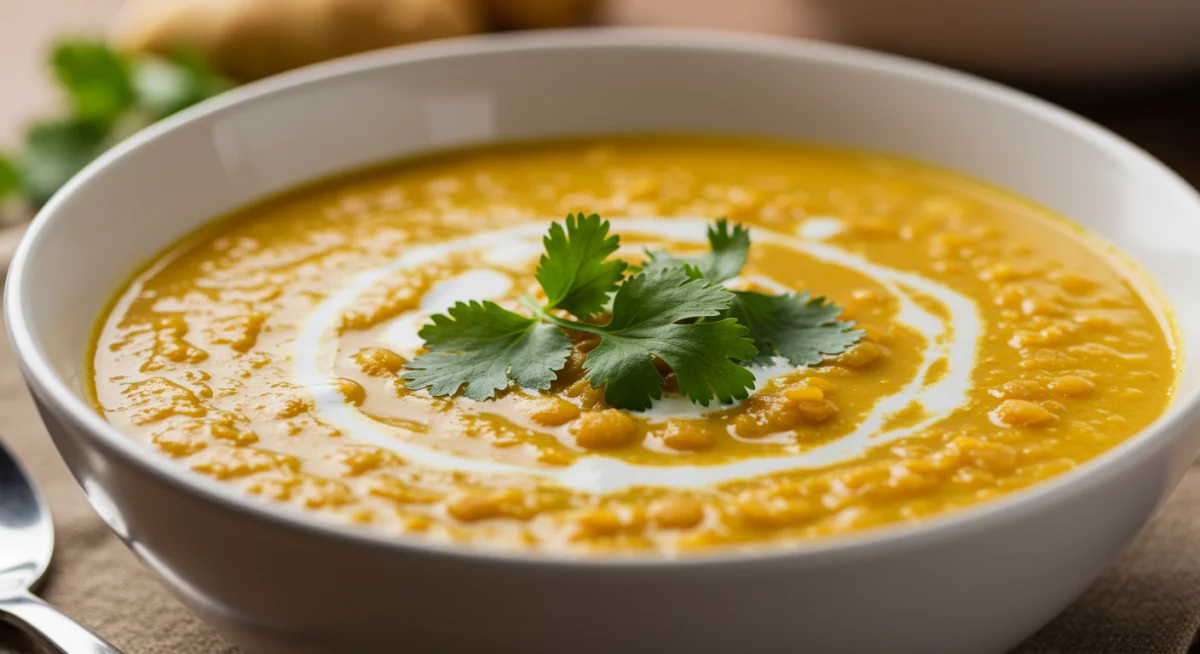
Insider strategies for sustainable inflammation reduction
Achieving a 20% reduction in chronic inflammation isn’t just about the food you eat; it’s also about adopting a holistic approach to your lifestyle. While diet is a powerful tool, integrating other mindful practices can significantly amplify your results, leading to more sustainable and profound health improvements. These insider strategies go beyond the plate, addressing the multifaceted nature of inflammation.
The goal is to create an environment within your body that actively resists inflammatory triggers. This involves not only nourishing your gut but also managing stress, optimizing sleep, and engaging in regular physical activity. Each of these components plays a crucial role in maintaining overall balance and reducing the systemic burden of inflammation.
Beyond diet: lifestyle adjustments
While food is foundational, several lifestyle factors contribute significantly to chronic inflammation. Addressing these areas can provide substantial benefits:
- Stress management: Chronic stress can trigger inflammatory pathways. Practices like meditation, yoga, or deep breathing can help.
- Adequate sleep: Lack of sleep elevates inflammatory markers. Aim for 7-9 hours of quality sleep per night.
- Regular exercise: Moderate physical activity reduces inflammatory cytokines and supports a healthy immune system.
- Hydration: Drinking enough water is essential for all bodily functions, including detoxification and nutrient transport, which indirectly impact inflammation.
Implementing these lifestyle adjustments alongside your anti-inflammatory diet creates a powerful synergy. They complement the benefits of healthy eating, fostering a more resilient and less inflamed body. Consistency in these practices is key to long-term success.
By understanding that inflammation is influenced by a combination of factors, you gain a more comprehensive perspective on managing your health. This holistic view empowers you to make impactful changes that extend far beyond just your meal choices, leading to a truly transformative reduction in chronic inflammation.
Making anti-inflammatory eating a lifestyle
Shifting to an anti-inflammatory diet doesn’t have to be a drastic overhaul; it’s about making conscious, consistent choices that accumulate over time. The key to long-term success lies in integrating these principles into your everyday life, transforming them from a temporary diet into a sustainable lifestyle. This approach ensures that the benefits of reduced inflammation become a permanent part of your health journey.
Think of it as an ongoing commitment to nourishing your body and supporting its natural healing processes. Small, incremental changes are often more effective and easier to maintain than radical dietary shifts. Focus on adding beneficial foods rather than strictly restricting, allowing for a more positive and empowering experience.
Meal prepping and planning for success
One of the most effective ways to maintain an anti-inflammatory lifestyle is through diligent meal prepping and planning. This strategy removes the guesswork and stress from daily eating, making healthy choices the default.
- Batch cooking: Prepare large quantities of grains (quinoa, brown rice) and roasted vegetables at the beginning of the week.
- Pre-chopped ingredients: Chop vegetables and store them in airtight containers for quick assembly of meals.
- Healthy snacks on hand: Keep berries, nuts, seeds, and pre-cut veggies readily available to avoid unhealthy cravings.
- Weekly meal plan: Outline your meals for the week, incorporating your favorite anti-inflammatory recipes, to ensure variety and adherence.
By investing a little time in planning and preparation, you set yourself up for consistent success. This proactive approach minimizes the chances of falling back into old habits and maximizes your ability to stick to your anti-inflammatory goals. It makes healthy eating convenient, enjoyable, and ultimately, a sustainable way of life.
Embracing an anti-inflammatory lifestyle is a journey, not a destination. With each mindful meal and healthy habit, you are actively working towards a stronger gut, a more balanced immune system, and a significant reduction in chronic inflammation, leading to a healthier and happier you.
Monitoring progress and adapting your approach
Embarking on an anti-inflammatory journey is a dynamic process that requires ongoing attention and responsiveness. It’s not a one-size-fits-all solution, and what works perfectly for one individual might need adjustments for another. Therefore, consistently monitoring your progress and being willing to adapt your approach are crucial for achieving and maintaining a 20% reduction in chronic inflammation by 2025.
Tracking your symptoms, energy levels, and even consulting with healthcare professionals can provide valuable insights into how your body is responding to dietary and lifestyle changes. This iterative process allows you to fine-tune your strategies, ensuring they remain effective and aligned with your unique physiological needs.
Tools and techniques for tracking inflammation
While you might not always feel inflammation directly, your body often sends subtle signals. Becoming attuned to these signals and using available tools can help you monitor your progress:
- Symptom journal: Keep a daily log of symptoms such as digestive discomfort, joint pain, skin issues, fatigue, or brain fog. Note improvements or flare-ups.
- Energy levels: Observe changes in your overall energy and vitality throughout the day.
- Blood tests: Regularly consult with your doctor for blood markers like C-reactive protein (CRP), erythrocyte sedimentation rate (ESR), and homocysteine, which can indicate systemic inflammation.
- Gut health tests: Consider advanced stool tests to assess your gut microbiome composition and identify any imbalances.
These tools provide objective and subjective data, offering a comprehensive view of your body’s inflammatory status. By consistently tracking and evaluating these metrics, you can make informed decisions about modifying your diet and lifestyle, ensuring you stay on track toward your anti-inflammatory goals. Remember, patience and persistence are key, as true healing often takes time.
Ultimately, the journey to reduce chronic inflammation is a personal one. By actively engaging in monitoring and adapting, you empower yourself to achieve lasting results, fostering a state of optimal health and well-being that truly transforms your life.

| Key Point | Brief Description |
|---|---|
| Gut-Inflammation Link | Dysbiosis and leaky gut trigger systemic chronic inflammation, making gut health crucial. |
| Key Ingredients | Prioritize turmeric, ginger, omega-3s, fiber, and antioxidants from diverse whole foods. |
| Holistic Approach | Combine diet with stress management, sleep, exercise, and hydration for best results. |
| Monitoring Progress | Track symptoms, energy, and blood markers to adapt strategies for sustained improvement. |
Frequently asked questions about anti-inflammatory gut health
Chronic inflammation is a persistent immune response linked to various diseases. Gut health is crucial because an imbalanced microbiome or ‘leaky gut’ can allow inflammatory triggers to enter the bloodstream, initiating or worsening systemic inflammation throughout the body.
Results vary, but many people report feeling improvements in energy and digestion within a few weeks. Significant reductions in chronic inflammation, as measured by markers like CRP, often take 2-3 months of consistent adherence to the diet and lifestyle changes.
To reduce inflammation, it’s generally recommended to minimize processed foods, refined sugars, unhealthy trans fats, excessive red and processed meats, and highly refined grains. Focus on whole, unprocessed foods as the foundation of your diet.
Certain supplements like omega-3 fatty acids, probiotics, vitamin D, and curcumin can support anti-inflammatory efforts. However, always consult a healthcare professional before starting any new supplements to ensure they are appropriate for your individual needs.
Generally, an anti-inflammatory diet rich in whole foods, fruits, vegetables, and healthy fats is beneficial for most individuals. However, those with specific health conditions or allergies should consult a doctor or registered dietitian for personalized advice and guidance.
Conclusion
Embracing the top 10 anti-inflammatory recipes for gut health in 2025, coupled with insider strategies, offers a powerful pathway to significantly reduce chronic inflammation and enhance overall well-being. This guide provides not just recipes, but a comprehensive framework for understanding the gut-inflammation connection and making sustainable lifestyle changes. By prioritizing nutrient-dense foods, managing stress, ensuring adequate sleep, and monitoring your progress, you can actively transform your health from the inside out, achieving a more vibrant and resilient future.
